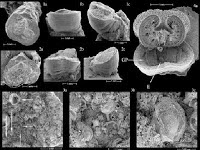Brachiopods
are Lophophorate animals related to Bryozoans and Phoranid Worms. They are superficially similar to Bivalve Molluscs, with a
filter feeding animal living between two opposed shells, but their
internal structure is quite different with a lophophore (net-like
organ) being extruded to capture planktonic prey rather than the
siphon of Bivalves which lets them pump in water and strain it for
food. This, along with a different muscle structure used to seal the
shell whch makes Brachiopods more vulnerable to predators such as
Starfish, has led to the Brachiopods being less ecologically
successful than the Bivalves in most environments, so that while
Brachiopods dominated many Palaeozoic benthic ecosystems and are
still extant today, they were progressively replaced in many
environments by their Mollusc rivals during the Mesozoic, and by the
end of the Cretaceous were uncommon members of invertebrate
communities.
In a
paper published in the Records of the Canterbury Museum on 29 September
2016, Norton Hiller of the Department of Geological Sciences at the
University of Canterbury and the Canterbury Museum, describes a new
species of Brachiopod from an exposure of the Mead Hill Formation on
the foreshore at Kaikoura in North Canterbury on South Island, New
Zealand. The fossils were discovered during a field trip by the
Geological Society of New Zealand in 2005, made to make that
organizations 50th anniversary, and were part of the first
collection of macro-invertebrate fossils collected from the Mead Hill
Formation, a collection that also included Sponges, Echinoid spines,
and a possible Belemnite.
The new
species is named Gowanella capralis, where 'Gowanella'
refers to the Gowan Hill Farm, on whose land the specimens were
found, and 'capralis' is a Latin word for a marsh, implying
land fit only for the grazing of Goats, a reference to the marshy
gully where the specimens were found. The species is described from
six complete shells, two lose dorsal valves and two broken ventral
valves. The shells are ventribiconvex, which is to say each half of
the shell is convex, with the two halves separated by a raised median
line (a common bodyplan in Brachiopods) and roughly hexagonal in
outline, with a short beak and short robust teeth on the ventral
valve.
Gowanella
capralis. (A−D) First specimen, complete shell in dorsal (A),
ventral (B), anterior (C), and lateral (D) views. (E) Second
specimen, juvenile complete shell in dorsal view. (F−I) Third
specimen, complete shell in dorsal (F), ventral (G), lateral (H), and
anterior (I) views. (J−M) Fourth specimen, complete shell in dorsal
(J), anterior (K), lateral (L), and ventral (M) views. (N) Fifth
specimen, dorsal valve in interior view. (O) Sixth specimen, dorsal
valve in interior view. (P-R) Seventh specimen, complete shell in
dorsal (P), lateral (Q), and anterior (R) views. Hiller (2016).
Hiller
also records a second type of Brachiopod from the Mead Hill deposits,
though the shells of these Brachiopods are less well preserved so
they are not formally described as a new species. There are ten of
these Brachiopods, all conjoined valve pairs all deformed by crushing
and tectonic deformation. They are subcircular in outline and have
narrow, erect beaks.
Second
Mead Hills Brachiopod. (A-C) First specimen, complete shell in dorsal
(A), lateral (B), and ventral (C), views. The exaggerated curvature
of the ventral valve is due to tectonic distortion. (D-F) Second
specimen, complete shell in dorsal (D), ventral (E), and lateral (F),
views. The thin shell at the growth margins of both these specimens
has been broken off. (G) Third specimen, complete shell in anterior
view showing broken anterior end with portion of the loop visible
(arrowed). Hiller (2016).
See also...
 Yuganotheca elegans: An Early Cambrian Lophophorate Animal with affinities to Brachiopods and Phoronids. Lophophorates are animals which feed using a...
Yuganotheca elegans: An Early Cambrian Lophophorate Animal with affinities to Brachiopods and Phoronids. Lophophorates are animals which feed using a...
Brachiopods (or Lampshells) superficially resemble Bivalve Molluscs,
though they are not closely related. They were abundant in the seas of
the Palaeozoic, often dominating benthic faunas, but today are
comparatively rare, and seldom seem outside the...
 Soft tissue preservation in Linguloid Brachiopods from the Early Ordovician Fenxiang Formation of Hubei Province, China.
Soft tissue preservation in Linguloid Brachiopods from the Early Ordovician Fenxiang Formation of Hubei Province, China.
Follow Sciency Thoughts on Facebook.



